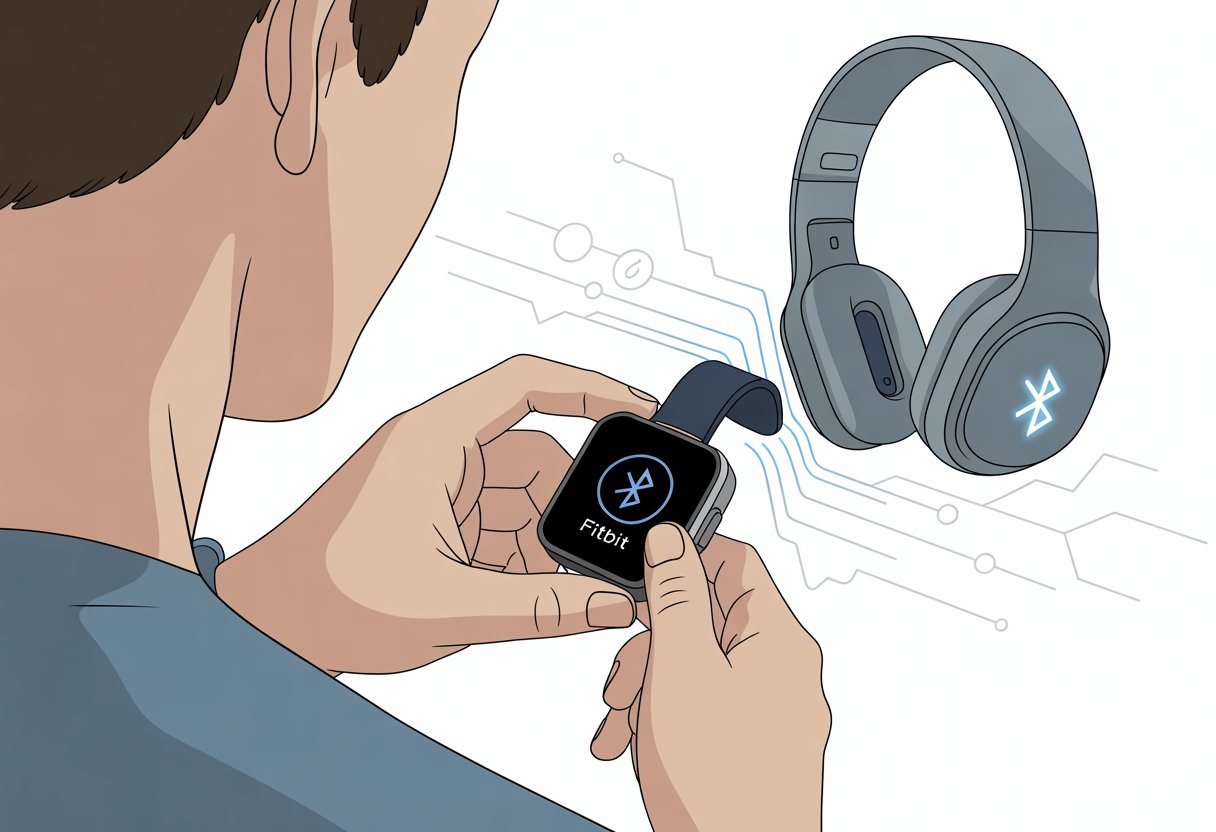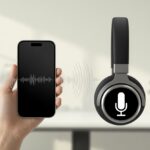Ever tried going for a jog, totally hyped for your favorite playlist, only to realize your headphones and Fitbit just aren’t connecting? Yeah, we’ve all been there—awkward silence, frantic button mashing, and suddenly zero motivation.
Pairing Bluetooth headphones with a Fitbit is honestly easier than putting together flat-pack furniture. No engineering degree required.

We just need the right steps and a bit of patience (sometimes a lot, depending on how moody our gadgets are). Let’s team up and finally get that playlist pumping through our headphones, not just in our heads.
Seriously, workouts feel way cooler when there’s actual music.
Understanding Bluetooth Compatibility with Fitbit
Not every Fitbit wants to play nice with our Bluetooth headphones. Some models are ready to jam, while others just quietly count steps.
It’s actually important to know which Fitbit we’ve got and what headphones will work, unless we enjoy troubleshooting for hours.
Which Fitbit Models Support Bluetooth Audio
Most Fitbits stick to syncing data and don’t bother with music. Only a few—like the Fitbit Versa line (Versa, Versa 2, Versa 3) and the now old-school Fitbit Ionic—let us pair with Bluetooth audio.
Don’t bother trying with the Inspire, Charge, or Luxe. They just don’t support Bluetooth headphones. The Fitbit Flyer was once the only official Fitbit headphones, but honestly, good luck finding one of those now.
If we’re not sure about our model, we can check the device settings or peek at Fitbit’s official compatibility guide.
Bluetooth Headphones Compatibility Requirements
Fitbit isn’t super picky, but there are some limits. Most standard Bluetooth headphones or speakers that use basic profiles (A2DP, for example) work with supported Fitbits.
That covers a lot of popular brands, from cheap earbuds to high-end headsets. Some weird or specialized devices—like fancy wireless musical instruments—might not connect.
Fitbit doesn’t support Bluetooth multipoint, so we can only connect headphones to one device at a time. For best results, our headphones should be in pairing mode and not linked to anything else.
Honestly, checking compatibility before buying new headphones is way better than spending Friday night arguing with electronics.
Limitations of Fitbit and Bluetooth Connections
We’d love to use our Fitbit as a portable DJ booth, but there are some annoying limits. Bluetooth audio only works for music we’ve stored locally and a few apps, depending on our Fitbit.
Streaming services like Spotify? We still need our phone for actual playback, even if we control them from the watch. Battery life takes a hit when we use headphones, so our Versa might start acting needy for a charger.
Fitbit lets us connect headphones, but not car stereos, Bluetooth speakers, or random electronics. If we try pairing with a piano or something, Fitbit just ignores it.
Pairing multiple headphones at once? Nope, Fitbit’s a one-at-a-time kind of device. If we wander too far from the watch, Bluetooth drops out. When that happens, it’s time for the classic move: turn it off and back on again.
Preparing Your Fitbit and Headphones for Pairing
Connecting Bluetooth headphones to a Fitbit gets way easier with a little prep. If everything’s charged, updated, and ready, we’ll spend less time fiddling and more time actually enjoying music—or pretending to, if we just want to look busy.
Charging Devices Before Pairing
It’s the worst when our headphones die halfway through a playlist, right after we finally get moving. Before pairing, we should charge both our Fitbit and headphones.
Fitbits usually need at least 50% battery for setup to go smoothly. Headphones should have at least one bar, but let’s just charge them fully to be safe.
No one wants a dead battery mid-workout. We should also find all the charging cables ahead of time, so we’re not scrambling at the last second.
Here’s a quick checklist:
| Device | Charged? | Cable Located? |
|---|---|---|
| Fitbit | ☐ | ☐ |
| Bluetooth Headphones | ☐ | ☐ |
When everything’s green, we’re ready.
Updating Fitbit Software
Pairing just works better when our Fitbit runs the latest software. Outdated software makes Bluetooth cranky.
To update, we open the Fitbit app, tap our device, and look for “Update Available.” If there’s an update, we hit it and let the Fitbit do its thing.
Sometimes updates take a few minutes, so we should resist the urge to keep tapping or yelling at the screen. Updates can fix Bluetooth bugs and help with battery life, so it’s worth doing now.
Ensuring Bluetooth Is Enabled
This might sound obvious, but Bluetooth needs to be on. On the Fitbit, we go to Settings, find the Bluetooth section, and make sure it’s enabled.
For headphones, we usually press and hold a button until a light blinks or we hear a beep—classic “pairing mode” stuff. That gets them ready to connect.
If Bluetooth is off, nothing will happen, and we’ll just end up talking to ourselves. Double-checking this step saves a lot of confusion. Once Bluetooth is on, Fitbit can scan for devices and find our headphones, as shown in this Fitbit pairing guide.
Step-by-Step Guide to Pair Bluetooth Headphones with Your Fitbit
Syncing Bluetooth headphones with a Fitbit can feel like teaching a goldfish to fetch, but if we break it down, we’ll have music on our morning jog soon enough.
Accessing the Bluetooth Settings on Fitbit
First, we grab our Fitbit—Versa or whichever model supports Bluetooth audio—and open the Settings app. We scroll down to Bluetooth settings, which Fitbit hides pretty well.
Inside the Bluetooth menu, we tap +Audio Device. Our Fitbit starts searching for nearby Bluetooth devices.
The on-screen instructions are usually simple, so we just follow along and try not to overthink it. Some Fitbits do things a bit differently, which can be frustrating.
If we get stuck, checking the manufacturer’s manual or support forums can actually help. For a quick walkthrough, there are videos online like this Bluetooth walkthrough for Fitbit Versa 2.
Putting Headphones into Pairing Mode
Now, let’s get the headphones ready. Most go into pairing mode if we hold the power button for a few seconds.
Sometimes there’s a flashing light, or maybe a beep. That’s the sign they’re ready.
Here’s a handy table:
| Headphone Type | Pairing Action |
|---|---|
| Most on-ear/over-ear | Hold power button until LED flashes |
| Earbuds | Put both buds in case, open lid, hold sync/power key |
| Fancy headphones | Check the manual—seriously, they like to be extra |
Keep the headphones close to the Fitbit. Even pets or walls can mess with the signal.
Headphones need to be in pairing mode before we start searching on the Fitbit, or they’ll just ignore each other.
Connecting and Troubleshooting the Pairing Process
If our headphone’s name pops up on the Fitbit, we tap it and hope for the best. Usually, there’s a sound or a message that says we’re paired.
If nothing shows up, don’t panic. Bluetooth can be weird. We should check if our headphones are already connected to something else—like our phone or even a neighbor’s device.
Unpair them everywhere else if needed. Restarting both the Fitbit and headphones often helps.
If things still don’t work, we can look in the Fitbit app or check Bluetooth settings on Android for permissions. The Fitbit Community forums are full of people who’ve had the same pairing headaches—like this Bluetooth pairing advice.
Bluetooth never makes total sense, but we can usually outsmart it (or at least outwait it).
Maximizing Your Music and Workout Experience
Turning up our favorite songs during a workout can actually make the treadmill feel epic. Let’s turn our Fitbit, Bluetooth headphones, and music into our personal hype squad.
Listening to Music from Your Fitbit
When we bring our Fitbit to the gym, we want music on our wrist—not a phone bouncing around. Some Fitbit devices, like the Versa series, let us play music directly from the watch to Bluetooth headphones.
First, we pair the headphones using the Settings app on the Fitbit. We tap “+ Audio Device” and let the watch scan for headphones. Once they’re connected, we’re good to go.
For help, check Google’s Fitbit Bluetooth audio device instructions.
We can store our own music on the Fitbit or use supported streaming services. Not all models let us download songs, so it’s smart to check before we start planning a wireless marathon playlist.).
Using Music Controls on Fitbit
Ever tried to skip a song mid-squat? Not fun, right? Fitbit actually makes music controls pretty easy, so we can stay in the groove—literally—without pausing our workout.
On most smart Fitbits, we find quick controls right on the screen or in the Music app. We can play, pause, skip tracks, and adjust the volume straight from the watch.
Some devices even let us change the volume with side buttons, which is a lifesaver when our fingers are sweaty and uncooperative.
Here’s a quick tip: if our headphones have their own controls, we can skip the watch entirely and double down on convenience.
The controls usually work even when our phone is nearby and connected, so it’s worth experimenting to see what feels best. If there’s ever a volume tug-of-war, the last device we touched usually wins.
Syncing Playlists and Transferring Songs
Syncing music to a Fitbit takes a bit of patience (and snacks help), but it means our runs and burpees always have a soundtrack. We need to install the Fitbit app on our computer to transfer personal music, like that embarrassing “guilty pleasures” playlist.
We connect our watch to Wi-Fi, open the Fitbit app, and pick which playlists to send over. Some Fitbits support apps like Deezer or Pandora, which make syncing even easier.
It can take a few minutes to move big playlists, so maybe strike a dramatic pose in the mirror while you wait.
Once we sync the music, it stays on the device until we decide it’s time for new jams. We can update playlists every week or just keep the same motivational tracks for months.
When in doubt, just remember: nothing says workout like “Eye of the Tiger”—even if we’re only taking out the trash.
Troubleshooting Common Problems
Trying to connect a Fitbit to Bluetooth headphones doesn’t always go smoothly. Sometimes we end up scratching our heads or even talking to our devices like they’ll answer—don’t worry, we’ve all done it.
Addressing Connection Issues
First, let’s check that Bluetooth is actually on. It sounds silly, but forgetting to check is pretty common.
Look for the little Bluetooth symbol on both the Fitbit and our headphones.
If the headphones don’t show up in the device list, they probably aren’t in pairing mode. Most headphones need us to hold down a button until a light blinks or something beeps.
If we’re lost, consult the world’s tiniest instruction manual, or check for help online, like this Fitbit Community discussion.
Still stuck? Try restarting both the Fitbit and the headphones. Turning things off and on again fixes more issues than we’d care to admit.
If that doesn’t work, forget the device in Bluetooth settings and try pairing again from scratch. It may feel like starting over, but sometimes our gadgets just need a fresh start.
And keep those batteries charged—dead headphones won’t pair with anything except disappointment.
Improving Bluetooth Performance
Even after connecting, we might hear audio cutting out or notice music pausing at random. Interference is often the culprit here.
Try keeping the Fitbit and headphones close together, at least when connecting for the first time.
Walls, appliances, and even the mighty fridge can block the Bluetooth signal. If we’re jamming in the kitchen and hear static, it’s probably not a ghost—just obstacles in the way.
Don’t skip software updates! Fitbit releases updates that often improve Bluetooth performance, so keeping our smartwatch up to date is a smart move.
Using too many Bluetooth devices at the same time can also confuse the Fitbit. Stick to connecting only what we need.
If battery life drops too quickly, close extra apps or dim the screen to save energy (and sanity). For more tips, check Google’s guide to Bluetooth audio on Fitbit.
Advanced Settings and Useful Features
We can do more with our Fitbit and Bluetooth headphones than just listen to music. Let’s see how we can get notifications delivered straight to our ears, set up sneaky silent alarms, and create reminders to move (because sometimes we need a little nudge).
Enabling Notifications Through Headphones
Ever wish our Fitbit could just read us our texts so we don’t have to squint at that tiny screen? When we pair Bluetooth headphones with certain Fitbit models, some notifications—like calls, texts, and calendar alerts—can come right through our headphones if the app and headphones support it.
To check if our Fitbit is actually being helpful, we need to open the Fitbit app. In the app settings, head to Notifications.
Here, we can choose which alerts we want. We should enable things like call and text notifications so we never miss a dramatic group chat update.
If our headphones don’t cooperate with notifications, it might be time for a firmware update—or maybe just a pep talk for the headphones. Not every Fitbit model supports every notification, and sometimes the headphone brand makes a difference.
For extra help, check this Google support guide for detailed steps.
Using Silent Alarms
Some of us don’t want to start the morning with a blaring alarm. That’s where silent alarms come in handy.
We can set these gentle vibrations from the Fitbit app or directly on the watch. Our wrist buzzes, but the rest of the house stays blissfully unaware.
We can use silent alarms for waking up, remembering to take medicine, or sneakily reminding ourselves to water the plants before they revolt.
The alarm’s vibration comes through our wrist, and depending on the headphones and device settings, a subtle ping in our headphones might back it up—so we’re less likely to miss it.
We can set up to eight different silent alarms at once.
Setting Up Reminders to Move
We all know sitting all day isn’t great for us, but sometimes we need a little push. Fitbit lets us set Reminders to Move from the Fitbit app.
We pick which hours we want reminders, and the device buzzes or pings if we haven’t taken at least 250 steps that hour.
When headphones are paired, we might even get a notification in our ears (depending on compatibility), usually as a gentle prompt, not a guilt trip.
Here’s how to set it up:
- Open the Fitbit app.
- Tap our device picture, then scroll to Reminders to Move.
- Turn it on and choose our target hours.
These nudges help us keep those steps up, whether we’re at work, at home, or dancing in the kitchen when no one’s looking.
Compatibility with Other Devices and Apps
We’re not just pairing headphones with a Fitbit—we’re juggling smartphones, computers, and a pile of apps that sometimes feel like they have minds of their own.
Keeping devices synced feels a bit like herding digital cats, but with the right steps, we can actually make tech play nice.
Pairing Fitbit with Smartphones and Computers
Fitbit watches love to connect with our smartphones, whether we’re on Android or iPhone. This keeps our activity data flowing into the Fitbit mobile app, so it’s easy to check our stats while pretending to work.
For computers—Mac or Windows—we mostly sync devices over Wi-Fi and Bluetooth. But most Fitbits don’t play audio over Bluetooth to computers; that connection is just for syncing data, not for music.
A quick tip: if our Bluetooth headphones are connected to the Fitbit, they won’t play music from our smartphone or laptop at the same time. Our Fitbit might act jealous and refuse to share.
For step-by-step help on which devices can pair with which gadgets, Fitbit’s support site is almost as good as having a techy friend on speed dial. See more at Fitbit support for Bluetooth audio devices.
Integrating Third-party Apps
We all want our favorite fitness and music apps, like Spotify or Pandora, to play nicely with our Fitbit. Some Fitbits let us control Spotify playlists right from the wrist—a dream for anyone tired of fishing their phone out mid-workout.
The Fitbit app gallery has a handful of third-party apps, but not every app from the Google Play Store or Apple App Store is available. It’s kind of like picking teams and hoping the cool apps don’t leave us out.
Syncing third-party apps with Fitbit means checking for compatibility and sometimes logging in to accounts we barely remember. While Fitbit’s own ecosystem is pretty smooth, some third-party apps need extra permissions, updates, or just a good old reboot to behave.
Managing Multiple Bluetooth Connections
Trying to keep our Fitbit, headphones, and other Bluetooth devices connected at once can feel like a game of technological Twister. Most Fitbit watches connect to one Bluetooth audio device and one phone at a time.
That means we can’t listen to music on more than one pair of headphones or switch audio between our laptop and Fitbit without disconnecting first.
A few things to remember:
- Bluetooth headphones can’t divide their loyalty: If paired with our Fitbit, they won’t play audio from our phone or computer until we disconnect.
- Pairing more than one device? Get ready to visit Bluetooth settings often, like we’re shuffling between buses on a commute.
- For more complex setups, like networking with laptops or other hardware, expect some trial and error. Turning off Bluetooth on unused devices can help free up connections.
If things go sideways, just unpair and try again. Troubleshooting Bluetooth sometimes feels like casting a spell—turn everything off, turn it back on, and cross your fingers.
For more help, Fitbit’s community forums are a goldmine of shared pain and solutions—like this discussion on pairing Versa with Bluetooth headphones.
Making the Most of Fitbit’s Fitness Tracking Features
With a Fitbit, we get a front-row seat to our health stats—no white coat or stethoscope required. These tools can help us track progress, figure out what works, and maybe even explain why our pants feel tighter after a weekend.
Using Fitness Metrics During Workouts
When we start a workout, our Fitbit counts every step, records distance (even the victory lap to the fridge), and tracks calories burned.
These numbers aren’t just pretty—they show if we’re moving enough to hit our daily goals.
There’s a weird sense of victory when we hear the buzz for 10,000 steps or finally burn off that mysterious “extra” cookie from last night.
We can check our progress in real time, so there’s no need to guess if we’re on track.
Plus, these metrics let us compete against ourselves. Who knew walking could feel so competitive?
We can pick the workout mode that fits us—running, biking, or cycling—since marathons aren’t everyone’s thing.
Our Fitbit keeps us motivated with reminders and those little trophy icons. Nothing says “fitness champ” like a tiny digital award.
Tracking Heart Rate and Active Minutes
Our heart rate isn’t just a ticking clock—it shows how hard our bodies are working. Fitbit tracks our heart rate all day and during exercise, showing the difference between chilling out and chasing after the dog.
Active minutes tell us how much time we really spend moving. We might think we’ve exercised a lot, but sometimes the numbers show that chasing the cat only counts for two minutes.
These stats help us push a little harder if we want our weekly average to impress friends—or just to earn an extra snack.
We even get alerts if our heart rate goes higher or lower than usual. It’s like having a tiny fitness coach on our wrist, minus the whistle.
Monitoring Sleep Stages and Quality
Fitbit doesn’t just track us while we’re awake—it follows our sleep, too, and honestly, it never even asks. We can check our sleep stages every night: light, deep, and REM.
It’s kind of wild when we realize how often we toss, turn, or wake up at 2 a.m. thinking about pizza. The sleep score shows how restful our night actually was.
If our sleep quality drops, Fitbit gives us tips to help. Sometimes it’ll suggest turning off late-night TV or skipping that “just one more” video game, and honestly, it’s probably right.
Looking at our trends over time, we get to laugh (or maybe cringe) at our habits. Are we night owls? Early birds? Or just really enthusiastic nappers?
Fitbit keeps us honest, one yawn at a time.
Safety, Security, and Payments
When we pair our Bluetooth headphones, safety and keeping our digital wallets secure matter, too. Fitbit isn’t just about steps and music—it also handles payments and privacy straight from our wrist.
Setting Up Fitbit Pay and NFC
Fitbit Pay lets us leave our wallets at home and just pay with a flick of the wrist. No more awkward wallet fumbles at the checkout.
Our watch uses built-in NFC (Near Field Communication) to make payments by holding the device near a compatible terminal. Here’s what we need to do:
- Open the Fitbit app on our phone.
- Go to device settings and select Fitbit Pay.
- Add our credit or debit card.
- Follow any extra steps from the bank, like a verification code.
Not all banks and cards work with Fitbit Pay, so checking compatibility first is a smart move. Nobody wants to look confused in the checkout line.
For extra security, every payment needs us to unlock the watch with a PIN code. If our watch ever goes missing, at least nobody’s out there buying sneakers on our card.
Securing Your Fitbit with a PIN Code
We trust our Fitbit with a lot—payments, steps, and those not-so-gentle nudges to stop binging Netflix. Setting up a PIN code just makes sense. It’s a quick way to keep strangers (or maybe a nosy little sibling) out of your device if you misplace it.
Here’s how you can set up a PIN:
- Open the settings menu on your watch.
- Tap Device Lock or PIN Code.
- Choose and enter your four-digit PIN.
You’ll need to punch in the code every time you put your Fitbit back on or if it’s been off your wrist for a bit. That extra step keeps your personal info and payment features just for you.
If you ever forget your PIN—don’t worry, it happens to the best of us—you can reset it with the Fitbit app. Or you can follow the steps in the user manual for Versa 2.
Honestly, nobody wants to lose their Fitbit and find out someone’s been buying snacks with it. Setting up a PIN helps you avoid that whole mess.
- Why is my fitness tracker not pairing with Apple Health? Troubleshooting for Technologically Cursed Mortals - December 22, 2025
- Why is my fitness tracker not updating firmware? Tech Tantrums and Update Woes Explained - December 21, 2025
- Why is the Sound Quality on My Bluetooth Headphones Poor? It’s Not Just Bad Music Taste! - December 21, 2025






